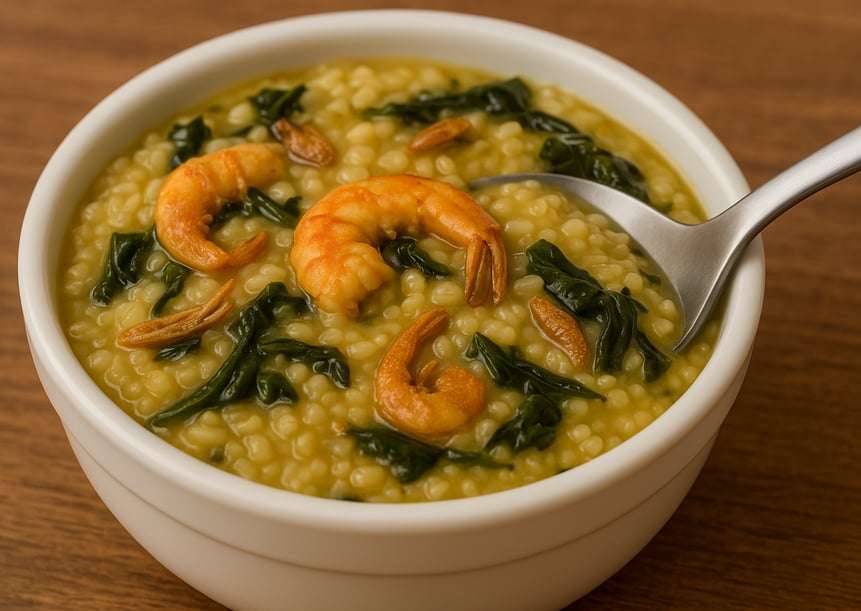The Untold Power of Paraense Rice
how Paraense Rice from the Amazon rivals Mediterranean cuisine in health benefits while delivering extraordinary flavors with tucupi, jambu, and fresh shrimp.
HEALTHY DISHES
CILZA DUARTE
5/24/20256 min read


When the Amazon River Meets Your Dinner Plate: The Untold Power of Paraense Rice
Ever caught yourself staring at that same old quinoa bowl, wondering if somewhere—perhaps in a distant, lush corner of the world—there's a dish that might actually make your taste buds dance again?
I was exactly there three summers ago, standing in my kitchen, Mediterranean diet cookbook in one hand, avocado toast in the other. (A cliché, I know, but we all have these moments of nutritional existential crisis.) Then, on a research trip to northern Brazil, I discovered something that made me question everything I thought I knew about "superfoods."
Paraense rice isn't just a dish. It's a cultural revelation wrapped in nutritional brilliance—a combination that might just give our beloved Mediterranean diet a run for its olive oil.
The Hidden Champion of the Amazon Basin
Let me paint you a picture: Imagine the Amazon River stretching like a massive life-giving vein through the world's greatest rainforest. Along its banks, culinary traditions have evolved not just for taste, but for survival and thriving in one of Earth's most demanding environments.
Paraense rice emerges from this crucible of necessity and abundance—specifically from Pará, a Brazilian state where the Amazon meets the Atlantic. This isn't your sad, plain white rice that sits neglected on your plate at chain restaurants. No, this is rice transformed through an alchemical marriage with some of the most nutritionally dense ingredients on the planet.
The dish combines ordinary rice with three extraordinary Amazonian ingredients that you probably won't find in your local supermarket (though, honestly, you should):
Tucupi: A yellow sauce extracted from wild manioc root that's been fermented and boiled until its toxins surrender, leaving behind a tangy, complex flavor that puts lemon juice to shame.
Jambu: An herb that literally makes your mouth tingle and temporarily numbs your tongue—nature's way of saying "pay attention to what you're eating, human!"
Fresh shrimp: Not the frozen, pale imitations you find at most seafood counters, but vibrant, just-caught treasures from the Amazon's tributaries.
Wait—did that sound like I'm exaggerating? I'm not. The first time I experienced jambu, I thought I was having some kind of allergic reaction. My dining companions laughed at the look on my face—the same expression, apparently, that every newcomer gets.
Mediterranean Diet, Meet Your Amazonian Cousin
Now, I love a good Greek salad as much as anyone. The Mediterranean diet deserves its stellar reputation—olive oil, fresh vegetables, lean proteins, whole grains. It's the golden child of the nutritional world, backed by decades of research showing benefits for heart health, longevity, and cognitive function.
But here's where things get interesting.
The Paraense diet—particularly dishes like this signature rice—shares remarkable parallels with Mediterranean eating patterns, but with a tropical, riverine twist that nutritionists are only beginning to fully appreciate.
Consider the nutritional breakdown:
Mediterranean diet foods deliver antioxidants through olive oil and red wine. Paraense rice gets its antioxidant punch from tucupi, which contains compounds that some preliminary research suggests may have anti-inflammatory properties that rival those in extra virgin olive oil. (Though admittedly, the research here is still emerging—the Amazon doesn't have quite the same research budget as the Mediterranean region.)
Where Mediterranean diets offer omega-3s through fish like sardines and mackerel, Paraense rice incorporates Amazon river shrimp—smaller but incredibly dense in protein and essential fatty acids.
And then there's jambu—an herb containing spilanthol, a compound being studied for potential benefits ranging from immune system support to oral health. Nothing in the Mediterranean pantry quite compares to this strange, electric herb that makes your mouth do a little samba.
How To Make Paraense Rice Without Booking a Flight to Brazil
"Isso não é para qualquer um" (This isn't for just anyone), my Paraense cooking instructor told me with a wink. She wasn't being elitist—she was acknowledging that this dish requires ingredients that might send you on a treasure hunt. But I promise: the pursuit is worth it.
Here's what you'll need:
2 cups of rice (ideally a medium-grain variety)
10.5 oz of cleaned shrimp
7 fl oz of tucupi (may be found in specialty Brazilian stores or online)
3.5 oz of cooked jambu (challenging to find fresh; sometimes available frozen in Brazilian markets)
1 chopped onion
2 crushed garlic cloves
1 tablespoon of olive oil (a small Mediterranean influence!)
Salt and black pepper to taste
Chopped cilantro for finishing
The preparation process embodies the beautiful simplicity that connects all great culinary traditions:
First, sauté the onion and garlic in olive oil until golden—creating that irresistible aromatic base that makes everyone in your house suddenly appear in the kitchen asking, "What smells so good?"
Add the shrimp and cook briefly—just enough to turn them pink and release their sweet oceanic flavor. Remember, we're not making shrimp jerky here.
Incorporate the rice, stirring to coat each grain with the flavorful base. This step is non-negotiable—it's where the foundation of flavor begins.
Pour in the tucupi and cook until the rice reaches that perfect tenderness. The liquid should be mostly absorbed, with just enough remaining to keep things slightly moist.
Mix in the cooked jambu and adjust the seasoning. This is where the magic happens—the slight numbing effect of jambu transforms the entire experience from "delicious rice dish" to "what is happening in my mouth right now?"
Finish with fresh cilantro, which adds a bright, grassy note that ties everything together.
When Worlds Collide: The Amazon-Mediterranean Health Connection
Na verdade, pensando melhor about how we categorize "healthy cuisines," I've started to see striking philosophical similarities between these seemingly distant food traditions.
Both the Mediterranean and Paraense approaches to eating prioritize:
Seasonal, fresh ingredients harvested at peak ripeness
Minimal processing, letting natural flavors speak for themselves
A reverential approach to water sources (sea vs. river)
Social eating as nutritional cornerstone—these are not meals meant to be eaten alone while scrolling through Instagram
Using food as preventative medicine
The Mediterranean diet has been extensively studied and proven to reduce risk factors for heart disease, certain cancers, and cognitive decline. The traditional diet of the Amazon basin—including staples like Paraense rice—hasn't received the same scientific attention, but the anecdotal evidence is compelling.
(I once met a 94-year-old woman in a small riverside community who credited her daily tucupi consumption for her remarkable vitality. She might have been onto something.)
Beyond Nutrition: The Cultural Richness We Can't Quantify
"Quem come jambu fica na Amazônia para sempre" (Whoever eats jambu stays in the Amazon forever), goes a local saying. It speaks to something our nutrition labels and calorie-counting apps can never capture—the way food connects us to place, community, and tradition.
When you prepare and eat Paraense rice, you're not just consuming nutrients. You're participating in a culinary tradition shaped by centuries of Indigenous wisdom, Portuguese colonial influence, and the overwhelming biodiversity of the Amazon.
Is this quantifiable in the same way we can measure the heart-healthy fats in olive oil? No. But anyone who's experienced true food cultures knows this intangible element matters just as much as any nutritional breakdown.
The Confluence of Traditions: Your Plate as Cultural Crossroads
Here's a wild thought that occurred to me while studying both these culinary traditions: What if the healthiest diet isn't Mediterranean or Amazonian, but rather one that embodies the wisdom of both?
Imagine drizzling a little extra virgin olive oil over your Paraense rice. Or incorporating jambu into your Greek salad. (Actually, I've tried this—the numbing effect paired with feta cheese creates a flavor experience I still can't adequately describe.)
The Mediterranean diet teaches us about balance, proportion, and the joy of simplistic preparation. The Amazonian approach reminds us that there are still flavors in this world that can genuinely surprise us, ingredients with properties we're just beginning to understand.
Together, they represent something I've come to believe deeply: that our healthiest future lies not in dogmatic adherence to a single regional diet, but in thoughtful integration of culinary wisdom from across the globe.
A Personal Confession from a Former Mediterranean Diet Purist
I used to be that person at dinner parties who couldn't stop talking about olive oil polyphenols and the Blue Zones. And look, those conversations still have merit. But my encounter with dishes like Paraense rice has humbled me.
It's reminded me that for all our nutritional science and diet books, we've barely scratched the surface of understanding the full spectrum of earth's edible treasures—especially those from regions less studied by Western researchers.
So next time you're planning a "healthy dinner," maybe look beyond the Mediterranean coastline. The banks of the Amazon hold culinary secrets that might just transform your understanding of what food can be.
As they say in Pará when presenting a particularly splendid meal: "Olha o que temos aqui!" (Look what we have here!) Indeed—look what we've had here all along, waiting to be discovered by those of us stuck in our Mediterranean comfort zones.
Will Paraense rice replace your Greek salad completely? Probably not. Should it have a place alongside it in your culinary repertoire? If you're serious about both nutritional diversity and taste adventures that wake up your palate—absolutely.
And isn't that expansion of possibilities—that willingness to look beyond the familiar—what truly nourishing food culture is all about?
#AmazonianSuperfood #ParaenseRice #HealthyEating #MyAmazonFood
Inspiration - Health
Explore recipes, tips, and culinary articles today.
wellness
Flavor
cilzaduarte@gmail.com
55 81 98087-8684
© 2025. All rights reserved.
